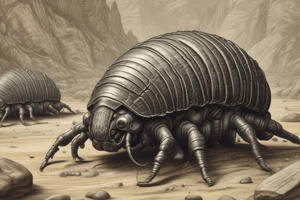Podcast
Questions and Answers
What is a defining characteristic of Phylum Nemertea?
What is a defining characteristic of Phylum Nemertea?
- Eversible muscular proboscis housed in a rhynchocoel (correct)
- Complete metamorphosis during larval stage
- Absence of any circulatory system
- Presence of a true coelom
Which of the following statements about Nemerteans is correct?
Which of the following statements about Nemerteans is correct?
- They have a 4-lobed brain and more complex nervous systems than flatworms. (correct)
- They are primarily herbivorous organisms.
- They reproduce only through asexual means.
- They exclusively inhabit freshwater environments.
What type of larva is most commonly found in the reproduction of Nemerteans?
What type of larva is most commonly found in the reproduction of Nemerteans?
- Planula larva
- Trochophore larva
- Ciliated larva 'mini-me' (correct)
- Metatrochophore larva
What method do Nemerteans primarily use for gas exchange?
What method do Nemerteans primarily use for gas exchange?
Which statement correctly describes the circulatory system in Nemerteans?
Which statement correctly describes the circulatory system in Nemerteans?
How do Nemerteans primarily move?
How do Nemerteans primarily move?
Which characteristic distinguishes Class Enopla from Class Anopla within Phylum Nemertea?
Which characteristic distinguishes Class Enopla from Class Anopla within Phylum Nemertea?
What type of digestive process do Nemerteans utilize?
What type of digestive process do Nemerteans utilize?
Which feature of Nemerteans indicates their bilaterally symmetrical body plan?
Which feature of Nemerteans indicates their bilaterally symmetrical body plan?
Which of the following is NOT a known habitat for most Nemertean species?
Which of the following is NOT a known habitat for most Nemertean species?
Flashcards
Phylum Nemertea
Phylum Nemertea
A phylum of ribbon worms characterized by a muscular, eversible proboscis housed in a fluid-filled cavity.
Proboscis
Proboscis
A muscular, eversible feeding structure found in Nemertea.
Rhynchocoel
Rhynchocoel
Fluid-filled cavity that houses the proboscis in Nemertea.
Triploblastic
Triploblastic
Signup and view all the flashcards
Bilaterally symmetrical
Bilaterally symmetrical
Signup and view all the flashcards
Complete digestive tract
Complete digestive tract
Signup and view all the flashcards
Closed circulatory system
Closed circulatory system
Signup and view all the flashcards
Protonephridia
Protonephridia
Signup and view all the flashcards
Gonochoristic
Gonochoristic
Signup and view all the flashcards
Anopla - Class
Anopla - Class
Signup and view all the flashcards
Study Notes
Cartoon Commentary
- A cartoon depicts two ants, one on a leaf with a laptop, commenting on the prospect of returning to a hill after adapting to remote work.
Invertebrate News
- Primitive comb jellies can fuse their bodies and nervous systems.
- This was reported by The New York Times.
- URL provided (https://www.nytimes.com/2024/10/07/science/comb-jellies-fusing-bodies.html)
Invertebrate Zoology Lecture
- Lecture 11 was given on 10/11/2024.
- Previous topics covered were Gnathifera, Rotifera, and Acanthocephala.
- Upcoming topics include Nemertea, beast profiles, Sharon & Grace, Phylum Mollusca, Part 1, and Exam Review.
Invertebrate Phylogeny
- Diagram depicting evolutionary relationships among invertebrates.
- Shows major lineages (e.g., Porifera, Cnidaria, Platyhelminthes, Mollusca, Annelida, Arthropoda).
- Features characteristics like segmentation and patterns of development (protostome, deuterostome).
- Indicates ancestral relationships.
Phylum Nemertea: Ribbon Worms
- ~1300 species
- Mostly free-living marine worms (some pelagic, terrestrial or parasitic)
- Found in various benthic environments (inside shells, under stones, in algae tangles and mud/sand)
- Long and thin, ribbon-like bodies, often with slime
- Typically 2 meters or less in length, but sometimes up to 60 meters.
- Often colorful.
Defining Characteristic of Nemertea
- Muscular eversible proboscis (feeding structure) housed in a fluid-filled schizocoelous cavity (rhynchocoel).
Nemertean Biology, Habits, and Reproduction
- Triploblastic (three germ layers)
- Acoelomate (no coelom) but has schizocoelous cavity
- Bilaterally symmetrical
- Ciliated epidermis
- Primarily gonochoristic (separate sexes), though some reproduce asexually via fragmentation and regeneration
- External fertilization, some with ciliated larval stages (e.g., pilidium larva)
- Predominant gas exchange method is diffusion.
Nemertean Circulatory, Nervous, and Excretory Systems
- True blood vascular system (closed circulatory system) with no heart (body wall muscles provide force)
- Contractile vessels potentially modify coelomic spaces (which can possibly mean the existence of a coelom).
- Excretion via protonephridia with flame cells.
- Relatively simple 4-lobed brain with nerve cords and ganglia, sensory structures like eyes and chemoreceptors, and mechanoreceptors (some species have statocysts).
Nemertean Locomotion
- Glide on slime trails (cilia)
- Muscular waves for crawling
- Undulatory swimming movements
Nemertean Feeding & Digestion
- Complete digestive tract (with both extracellular & intracellular digestion)
- Primarily carnivores
- Eversible proboscis for prey capture.
- Proboscis is not homologous with turbellarian pharynx (it evolved differently).
- Proboscis retractor muscles hold it in case of retraction.
- Rhynchocoel is a space within the mesodermal tissue where the proboscis is housed.
Nemertea: Gorgon Worm
- Note on a type of Nemertean and its feeding mechanism: a proboscis to capture prey.
Nemertea Classification
- Class Anopla (no stylet)
- Class Enopla (with stylet)
Studying That Suits You
Use AI to generate personalized quizzes and flashcards to suit your learning preferences.




